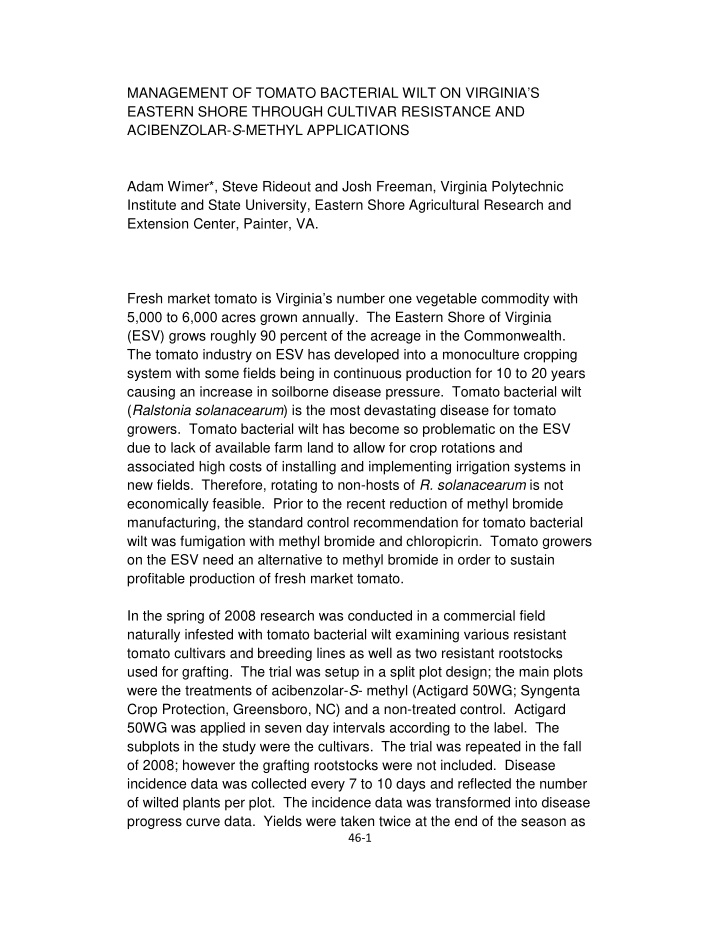



MANAGEMENT OF TOMATO BACTERIAL WILT ON VIRGINIA’S EASTERN SHORE THROUGH CULTIVAR RESISTANCE AND ACIBENZOLAR- S -METHYL APPLICATIONS Adam Wimer*, Steve Rideout and Josh Freeman, Virginia Polytechnic Institute and State University, Eastern Shore Agricultural Research and Extension Center, Painter, VA. Fresh market tomato is Virginia’s number one vegetable commodity with 5,000 to 6,000 acres grown annually. The Eastern Shore of Virginia (ESV) grows roughly 90 percent of the acreage in the Commonwealth. The tomato industry on ESV has developed into a monoculture cropping system with some fields being in continuous production for 10 to 20 years causing an increase in soilborne disease pressure. Tomato bacterial wilt ( Ralstonia solanacearum ) is the most devastating disease for tomato growers. Tomato bacterial wilt has become so problematic on the ESV due to lack of available farm land to allow for crop rotations and associated high costs of installing and implementing irrigation systems in new fields. Therefore, rotating to non-hosts of R. solanacearum is not economically feasible. Prior to the recent reduction of methyl bromide manufacturing, the standard control recommendation for tomato bacterial wilt was fumigation with methyl bromide and chloropicrin. Tomato growers on the ESV need an alternative to methyl bromide in order to sustain profitable production of fresh market tomato. In the spring of 2008 research was conducted in a commercial field naturally infested with tomato bacterial wilt examining various resistant tomato cultivars and breeding lines as well as two resistant rootstocks used for grafting. The trial was setup in a split plot design; the main plots were the treatments of acibenzolar- S - methyl (Actigard 50WG; Syngenta Crop Protection, Greensboro, NC) and a non-treated control. Actigard 50WG was applied in seven day intervals according to the label. The subplots in the study were the cultivars. The trial was repeated in the fall of 2008; however the grafting rootstocks were not included. Disease incidence data was collected every 7 to 10 days and reflected the number of wilted plants per plot. The incidence data was transformed into disease progress curve data. Yields were taken twice at the end of the season as 46-1
the plants became ready for harvest. The results from the spring and fall trials showed promise for a number of breeding lines and resistant cultivars. The spring trial showed excellent resistance to bacterial wilt, however only BHN 669 showed significantly higher yields than most of the other resistant cultivars (Table 1). Disease pressure in the fall trial was minimal. However, in the fall trial, resistant cultivar BHN 669 and the resistant breeding line FLA 7997 showed significantly higher yields than most of the cultivars included in the study (Table 2). In both the spring and fall trials the cultivars that received actigard were not significantly different than those cultivars that did not receive treatments of actigard (Tables 3 and 4). The results from these trials indicate that breeding efforts are beginning to show promise for managing this disease. For growers who have high levels of disease in their fields, resistant cultivars with greater yield potential and more acceptable agronomic characteristics should become available in the future alleviating some of their losses due to tomato bacterial wilt. Table 1. Bacterial wilt incidence (AUDPC) and yield for the individual cultivars included in the spring 2008 trial. Cultivar Bacterial Wilt (AUDPC) Yield boxes/A Red Line 76. 6 c 956 bc CRA 66 0 d 0 f FLA 7997 9.5 d 840 cd FLA 8109B 11.6 d 525 de FLA 8599 0.7 d 944 bc FLA 8626 2.1 d 1242 ab PI126408 1.6 d 0 f BHN682 7.4 d 1037 bc BHN669 12.4 d 1481 a Sacramento 145.8 a 396 e Sunguard on 105* 8.8 d 525 de BHN602 on 106* 12.3 d 558 de BHN602 on 113.4 b 392 e BHN602* Values with the same letter indicate no significant difference. All values significant at P = 0.05 according to Fisher’s LSD * grafted cultivar 46-2
Table 2. Yield of the individual varieties included in the fall 2008 trial. Variety Yield boxes/acre Red Line 1303 bc CRA 66 0 e FLA 7997 1530 ab FLA 8109B 912 d FLA 8599 1453 b FLA 8626 1191 c PI126408 0 e BHN669 1754 a Sacramento 727 d Values with the same letter indicate no significant difference. All values significant at P = 0.05 according to Fisher’s LSD Table 3. Bacterial wilt incidence and yield of treatments that received Actigard applications versus the nontreated control in the spring of 2008. Treatment Bacterial Wilt (AUDPC) Yield Boxes/A Actigard 46.5 a 627 a NTC 36.2 a 742 a NTC: non treated control. Values with the same letter indicate no significant difference. All values significant at P = 0.05 according to Fisher’s LSD. Table 4. Yield of treatments that received actigard and treatments that did not receive Actigard in the fall 2008 trial. Treatment Yield boxes/acre Actigard 1162 a NTC 1367 a NTC: non treated control. Values with the same letter indicate no significant difference. All values significant at P = 0.05 according to Fisher’s LSD 46-3
Recommend
More recommend